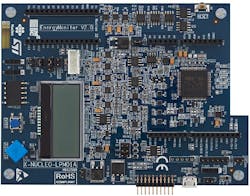STM32 Power Shield Checks EEMBC’s ULPMark Power Benchmarking
STmicroelectronics’ STM32 Power Shield allows developers to check the power consumption of embedded designs. It is based on the X-NUCLEO-LPM01A board and is designed to run EEMBC’s IoTConnect and ULPMark benchmarking frameworks.
The X-NUCLEO-LPM01A runs an STM32L496VGT6 Cortex-M4 microcontroller that can manage 3.2 Msamples/s power measurements while providing a programmable voltage source for a device under test (DUT). The LCD display allows standalone operation.
The board is a programmable voltage source (1.8 to 3.3 V) designed for testing power consumption of low-power embedded systems. It runs an 80 MHz STM32L496VGT6 Cortex-M4 that includes three 5 Msample/s 12-bit ADCs. This allows it to do dynamic power measurements with a 100 kHz bandwidth at 3.2 Msamples/s. It can measure currents ranging from 100 nA to 50 mA within about a 2% accuracy. Its static current measurement support runs from 1 nA to 200 mA. The system does subsampling to allow graphical rendering of power consumption in real-time.
The system can be controlled from a PC via a USB interface. The graphical STM32CubeMonitor-Power PC tool can run on Windows, Linux, and MacOS. The software can save and load acquired trace data for analysis. Trace analysis can help identify problem areas or areas where power optimization may be useful.
There is also an on-board, 2-line LCD display and 4-axis joystick for standalone operation. There is a USB-based COM port command line interface that can also be used to control the system.
A device under test (DUT) board can plug into the Arduino Uno/Nano-compatible socket. There are also wire headers for custom connections to any other DUTs. Power to the X-NUCLEO-LPM01A can be provided by the USB connection, an external power source (7 to 10 V), or via the Arduino connector.
EEMBC’s IoTConnect and ULPMark have become the standards for benchmarking in the low-power embedded space. Microcontrollers are often highlighted with results from these tests comparing them to competitors. This is handy for knowing how chips relate to each other, but the tests can also be useful in gauging the performance of a system as well as examining how hardware and software changes affect power utilization. This can be especially critical in battery operated and ultra low-power applications.
About the Author
William G. Wong
Senior Content Director - Electronic Design and Microwaves & RF
I am Editor of Electronic Design focusing on embedded, software, and systems. As Senior Content Director, I also manage Microwaves & RF and I work with a great team of editors to provide engineers, programmers, developers and technical managers with interesting and useful articles and videos on a regular basis. Check out our free newsletters to see the latest content.
You can send press releases for new products for possible coverage on the website. I am also interested in receiving contributed articles for publishing on our website. Use our template and send to me along with a signed release form.
Check out my blog, AltEmbedded on Electronic Design, as well as his latest articles on this site that are listed below.
You can visit my social media via these links:
- AltEmbedded on Electronic Design
- Bill Wong on Facebook
- @AltEmbedded on Twitter
- Bill Wong on LinkedIn
I earned a Bachelor of Electrical Engineering at the Georgia Institute of Technology and a Masters in Computer Science from Rutgers University. I still do a bit of programming using everything from C and C++ to Rust and Ada/SPARK. I do a bit of PHP programming for Drupal websites. I have posted a few Drupal modules.
I still get a hand on software and electronic hardware. Some of this can be found on our Kit Close-Up video series. You can also see me on many of our TechXchange Talk videos. I am interested in a range of projects from robotics to artificial intelligence.



